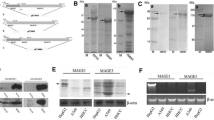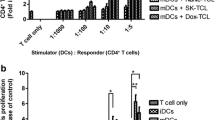Abstract
HER2/neu peptide-based vaccines can eliminate human tumors overexpressing the human epidermal growth factor receptor 2 (HER2/neu), but the efficacy of this therapeutic strategy is suboptimal. Heat shock proteins (HSPs) are capable of eliciting efficient cytotoxic T lymphocyte (CTL) responses by cross-presentation. To evaluate whether immunization with a HSP65–HER2 fusion peptide could selectively eliminate HER2+ B16 melanoma cells in a xenograft tumor mouse model, a HSP65–HER2 fusion peptide was incubated with immature dendritic cells (iDCs) in vitro to determine whether loading of iDCs with HSP65–HER2 could induce the expression of the immunomodulatory cell surface molecule, CD86. In vivo mouse immunizations with HSP65–HER2 or PBS (control) were performed to determine the antitumor effects by longitudinally monitoring changes in tumor volume, weight, and incidence. The effects on percentages of HER2+ B16 cells in tumors were assessed by confocal microscopy and flow cytometry. The results indicated that loading of iDCs with HSP65–HER2 induced the expression of CD86 in vitro, suggesting that the hybrid antigen was able to stimulate an immune response. Immunization with HSP65–HER2 had no significant influence on tumor weight or volume but significantly reduced tumor incidence (62.5 % in mice injected with 25 μg of HSP65–HER2 vs. 100 % in PBS-injected controls; P < 0.05). Confocal microscopy and flow cytometry analyses revealed that HSP65–HER2 immunization significantly reduced the percentages of HER2+ B16 cells in xenografted tumors (1.86 % vs. 30.56 % in PBS-injected controls; P = 0.01). Our findings suggest that immunization with the HSP65–HER2 fusion peptide selectively eliminates HER2+ B16 melanoma cells in a xenograft tumor mouse model and may represent a novel and efficacious targeted therapy of HER2/neu+ tumors.






Similar content being viewed by others
References
Arteaga CL, Sliwkowski MX, Osborne CK, Perez EA, Puglisi F, Gianni L. Treatment of HER-2-positive breast cancer: current status and future perspectives. Nat Rev Clin Oncol. 2011;9:16–32.
Pauletti G, Godolphin W, Press MF, Slamon DJ. Detection and quantitation of HER-2/neu gene amplification in human breast cancer archival material using fluorescence in situ hybridization. Oncogene. 1996;13:63–72.
Scheurle D, Jahanzeb M, Aronsohn RS, Watzek L, Narayanan R. HER-2/neu expression in archival non-small cell lung carcinomas using FDA-approved Hercep test. Anticancer Res. 2000;20:2091–6.
Seliger B, Rongcun Y, Atkins D, et al. HER-2/neu is expressed in human renal cell carcinoma at heterogeneous levels independently of tumor grading and staging and can be recognized by HLA-A2.1-restricted cytotoxic T lymphocytes. Int J Cancer. 2000;87:349–59.
Blume-Jensen P, Hunter T. Oncogenic kinase signalling. Nature. 2001;411:355–65.
Pritchard KI, Shepherd LE, O'Malley FP, et al. HER-2 and responsiveness of breast cancer to adjuvant chemotherapy. N Engl J Med. 2006;354:2103–11.
Emens LA, Reilly RT, Jaffee EM. Breast cancer vaccines: maximizing cancer treatment by tapping into host immunity. Endocr Relat Cancer. 2005;12:1–17.
Emens LA, Jaffee EM. Cancer vaccines: an old idea comes of age. Cancer Biol Ther. 2003;2:S161–168.
Renard V, Sonderbye L, Ebbehøj K, et al. HER-2 DNA and protein vaccines containing potent Th cell epitopes induce distinct protective and therapeutic antitumor responses in HER-2 transgenic mice. J Immunol. 2003;171:1588–95.
Fu Q, Wu Y, Yan F, et al. Efficient induction of a HER-2-specific anti-tumor response by dendritic cells pulsed with a Hsp70L1-HER-2(341–456) fusion protein. Cell Mol Immunol. 2011;8:424–32.
Ladjemi MZ, Jacot W, Chardès T, Pèlegrin A, Navarro-Teulon I. Anti-HER-2 vaccines: new prospects for breast cancer therapy. Cancer Immunol Immunother. 2010;59:1295–312.
Bernhard H, Salazar L, Schiffman K, et al. Vaccination against the HER-2/neu oncogenic protein. Endocr Relat Cancer. 2002;9:33–44.
Salazar LG, Goodell V, O'Meara M, et al. Persistent immunity and survival after immunization with a HER-2/neu (HER-2) vaccine. J Clin Oncol. 2009;27:3010.
Choudhury A, Charo J, Parapuram SK, et al. Small interfering RNA (siRNA) inhibits the expression of the HER-2/neu gene, upregulates HLA class I and induces apoptosis of HER-2/neu positive tumor cell lines. Int J Cancer. 2004;108:71–7.
Herrmann F, Lehr HA, Drexler I, et al. HER-2/neu-mediated regulation of components of the MHC class I antigen-processing pathway. Cancer Res. 2004;64:215–20.
Vertuani S, Triulzi C, Roos AK, et al. HER-2/neu mediated down-regulation of MHC class I antigen processing prevents CTL-mediated tumor recognition upon DNA vaccination in HLA-A2 transgenic mice. Cancer Immunol Immunother. 2009;58:653–64.
Oura J, Tamura Y, Kamiguchi K, et al. Extracellular heat shock protein 90 plays a role in translocating chaperoned antigen from endosome to proteasome for generating antigenic peptide to be cross-presented by dendritic cells. Int Immunol. 2011;23:223–37.
Suto R, Srivastava PK. A mechanism for the specific immunogenicity of heat shock protein-chaperoned peptides. Science. 1995;269:1585–8.
Castellino F, Boucher PE, Eichelberg K, et al. Receptor-mediated uptake of antigen/heat shock protein complexes results in major histocompatibility complex class I antigen presentation via two distinct processing pathways. J Exp Med. 2000;191:1957–64.
Moroi Y, Mayhew M, Trcka J, et al. Induction of cellular immunity by immunization with novel hybrid peptides complexed to heat shock protein 70. Proc Natl Acad Sci USA. 2000;97:3485–90.
Xiang ZM. Construction and functional study of heat shock protein 65-HER2 multi-epitopes fusion. PhD thesis, Jilin University, 2006.
Blachere NE, Li Z, Chandawarkar RY, et al. Heat shock protein–peptide complexes, reconstituted in vitro, elicit peptide specific cytotoxic T lymphocyte response and tumor immunity. J Exp Med. 1997;186:1315–22.
Nanda NK, Sercarz EE. Induction of anti-self-immunity to cure cancer. Cell. 1995;82:13–7.
Seavey MM, Pan ZK, Maciag PC, et al. A novel human Her-2/neu chimeric molecule expressed by Listeria monocytogenes can elicit potent HLA-A2 restricted CD8-positive T cell responses and impact the growth and spread of Her-2/neu-positive breast tumors. Clin Cancer Res. 2009;15:924–32.
Holmes JP, Benavides LC, Gates JD, et al. Results of the first phase I clinical trial of the novel II-key hybrid preventive HER-2/neu peptide (AE37) vaccine. J Clin Oncol. 2008;26:3426–33.
Khong HT, Restifo NP. Natural selection of tumor variants in the generation of “tumor escape” phenotypes. Nat Immunol. 2002;3:999–1005.
Garcia-Lora A, Algarra I, Garrido F. MHC class I antigens, immune surveillance, and tumor immune escape. J Cell Physiol. 2003;195:346–55.
Seliger B. Strategies of tumor immune evasion. BioDrugs. 2005;19:347–54.
Pilon SA, Kelly C, Wei WZ. Broadening of epitope recognition during immune rejection of ErbB-2-positive tumor prevents growth of ErbB-2-negative tumor. J Immunol. 2003;170:1202–8.
Vanderlugt CL, Miller SD. Epitope spreading in immune-mediated diseases: implications for immunotherapy. Nature Rev Immunol. 2002;2:85–95.
Conflicts of interest
None
Author information
Authors and Affiliations
Corresponding author
Rights and permissions
About this article
Cite this article
Wang, J., Wang, X., Chen, Y. et al. Immunization with a HSP65–HER2 fusion peptide selectively eliminates HER2+ B16 melanoma cells in a xenograft tumor mouse model. Tumor Biol. 34, 193–201 (2013). https://doi.org/10.1007/s13277-012-0529-6
Received:
Accepted:
Published:
Issue Date:
DOI: https://doi.org/10.1007/s13277-012-0529-6




